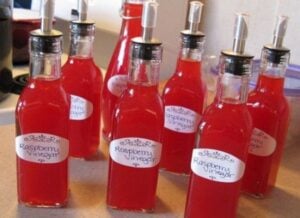How To Make Your Own Fruit Vinegar

Fruit vinegars are fantastic for adding a bit of extra flavor and depth to any salad dressing, meat or veggie marinade, pickling broth or sauce. Apple cider vinegar is the most common fruit vinegar, but consider the endless possibilities with pear, plum, raspberry, blackberry, loganberry, persimmon–or even tomato vinegar. These delectable flavors will have you hooked as soon as you taste them, as will this simple and economical recipe for homemade fruit vinegar. Not to mention, you’ll love the added benefit of excluding all those distillation chemicals and GMO ingredients used in the production of many store-bought vinegars.
Fruit vinegars can easily be made from the peels and cores of apples and pears, as well as second grade fruits that you might be able to get from a farmers market, your own backyard, a friend or neighbor with fruit trees and berry vines. Bruised and smashed fruits are great for making vinegar and reducing waste, so ask your local grocery store if they can sell them to you for a discounted price. Ever freezer burned fruit, once thawed, works fine for making this recipe in any season.
So, the next time you plan on making apple sauce or persimmon relish, save those fruit scraps and turn them into this delicious dressing ingredient. The following recipe yields around 2-2 1/2 cups of vinegar; so multiply your proportions depending on the availability of fruit scraps.
Ingredients
2 cups organic apple or pear peels and cores / any type of berry / tomato skins and seeds / plum, peach, apricot or nectarine skins (any part of these fruits will work)
4 cups water
1 teaspoon organic white or brown sugar (optional for speeding up the fermentation process – will add extra flavor!)
Method
Place your fruit scraps into a large (at least ½ gallon size), wide mouth mason or regular glass jar or a stone crock. Add the water and optional white or brown sugar. Cover the container with a muslin cloth to prevent dust, bugs or anything else falling into your vinegar solution. Place the container in a place where it can ferment undisturbed, preferably out of direct sunlight.
Let the fruit scraps and water sit for about 8 weeks, during which time a thick layer of goopy scum will form on the top. This scum, also known as the ‘mother’, is cellulose produced by acetic acid bacteria, which is ubiquitous in nature and present in all fermented, unpasteurized foods. The bacteria becomes present whenever ethanol is produced, which is what is happening when wild, airborne yeasts are feeding on the sugar in your fruit scraps. Fruit flies carry acetic acid bacteria in their bodies, and so are actually an effective way to expedite vinegar making. If you want to allow fruit flies to help ferment your fruit scraps, keep your vinegar solution uncovered for about a day after beginning the process, check to see if any flies have landed, and cover the container with a cloth.
After the 8-week period, strain the liquid into a glass bottle through several layers of cheesecloth, a mesh bag or a fine mesh strainer, and cover with a metal cap or a cork stopper. After another 4 weeks, strain the liquid again through a clean cloth about the thickness of muslin into the bottle you want to store the vinegar in. Cap it, label it and you’ll have the fantastically fruity and tasty addition to your kitchen ingredients!
NOTE: A mother may re-develop in your finished vinegar, which will look a floating, gelatinous mass at the bottom of your bottle. Don’t throw this away! Much like a sourdough bread starter, it will kick-start future vinegar making processes, so save it in a small jar once you get to the end of your bottle.
Image: veganheathen

